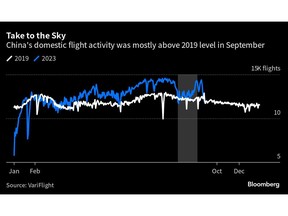China’s economic growth last quarter probably undershot Beijing’s annual target for 2023 as the property sector and subdued demand weighed on activity, a sign of the recovery’s fragility as the government reportedly mulls more stimulus.
Author of the article:
Bloomberg News
Bloomberg News
Published Oct 16, 2023 • 5 minute read
 9i(lkm1p2x7falmumjqh8mhz_media_dl_1.png Source: VariFlight
9i(lkm1p2x7falmumjqh8mhz_media_dl_1.png Source: VariFlight
(Bloomberg) — China’s economic growth last quarter probably undershot Beijing’s annual target for 2023 as the property sector and subdued demand weighed on activity, a sign of the recovery’s fragility as the government reportedly mulls more stimulus.
Data due Wednesday will likely show gross domestic product expanded 4.5% in the July-to-September period from a year earlier — below the official full-year target of about 5%. GDP growth from the prior quarter likely picked up slightly. Authorities will also release data on industrial output, retail sales, investment and unemployment.
Advertisement 2
This advertisement has not loaded yet, but your article continues below.
THIS CONTENT IS RESERVED FOR SUBSCRIBERS ONLY
Subscribe now to read the latest news in your city and across Canada.
Exclusive articles by Kevin Carmichael, Victoria Wells, Jake Edmiston, Gabriel Friedman and others.Daily content from Financial Times, the world’s leading global business publication.Unlimited online access to read articles from Financial Post, National Post and 15 news sites across Canada with one account.National Post ePaper, an electronic replica of the print edition to view on any device, share and comment on.Daily puzzles, including the New York Times Crossword.
SUBSCRIBE TO UNLOCK MORE ARTICLES
Subscribe now to read the latest news in your city and across Canada.
Exclusive articles by Kevin Carmichael, Victoria Wells, Jake Edmiston, Gabriel Friedman and others.Daily content from Financial Times, the world’s leading global business publication.Unlimited online access to read articles from Financial Post, National Post and 15 news sites across Canada with one account.National Post ePaper, an electronic replica of the print edition to view on any device, share and comment on.Daily puzzles, including the New York Times Crossword.
REGISTER TO UNLOCK MORE ARTICLES
Create an account or sign in to continue with your reading experience.
Access articles from across Canada with one account.Share your thoughts and join the conversation in the comments.Enjoy additional articles per month.Get email updates from your favourite authors.
Article content
Article content
A growth rate slowing below the government’s annual goal may create a case for policymakers to step up support for the economy. While stimulus so far has appeared to have some impact — factory activity improved and a drop in exports moderated — consumer prices in September slowed to the brink of deflation and loan growth was weak.
Some economists have been raising their forecasts in recent weeks as they anticipate China just about hitting its growth target for 2023 — though it’s not a sure bet and any weakness in the data may suggest a need for President Xi Jinping’s government to do more to support the recovery.
Authorities are considering raising this year’s budget deficit by issuing more debt to spend on infrastructure, Bloomberg News reported last week, and are also mulling ways to shore up stock market confidence. Economists are expecting China to further cut interest rates and banks’ reserve requirement ratio this year.
“We believe it’s still too early to call the bottom,” said Nomura Holdings Inc. economists led by Lu Ting in a Tuesday note. “We expect a triple dip towards year-end or early 2024, and Beijing may have to step up its efforts to stabilize growth again at that time.”
By signing up you consent to receive the above newsletter from Postmedia Network Inc.
Article content
Advertisement 3
This advertisement has not loaded yet, but your article continues below.
Article content
If the third-quarter GDP data shows growth of 4.5%, Lu projects the final three months of the year would have to match that pace for Beijing to hit its target.
The National Bureau of Statistics is expected to release September and third-quarter economic data Wednesday at 10 a.m. local time. Here’s what to watch:
Industrial Production
Industrial output is projected to have increased 4.4% year-on-year in September, according to economists polled by Bloomberg. That’s a bit lower than August’s 4.5% pickup.
Even so, sequential growth has shown signs of improvement. Factory activity returned to expansion in September, according to an official survey, while a decline in exports narrowed further. High-frequency data also pointed to faster production of key construction materials, such as cement. Coal prices surged.
Power consumption in China jumped 9.9% last month from a year ago, the National Energy Administration said in a statement Monday, providing more evidence that economic activity has gained traction. However, the comparison base was relatively low, given that some southwestern provinces imposed power usage curbs amid a drought in September 2022.
Advertisement 4
This advertisement has not loaded yet, but your article continues below.
Article content
Retail Sales
Retail sales probably continued to rebound. Economists predict sales growth accelerated to 4.9% in September from a year earlier, higher than August’s 4.6% gain.
Data reflecting consumer confidence and spending has been mixed in the past few weeks. Policies to boost car purchases seem to have worked somewhat, with passenger vehicle sales rising 5% last month from a year ago — the most since May.
Household spending on services including travel, hotels and catering were lifted over the Golden Week holiday period that started in late September, though those figures weren’t as strong as the government had hoped. Not all of that data will feature in this week’s figures, since most of the holiday occurred in October.
Consumer prices surprisingly stalled in September, underscoring challenges to the economy. UBS Group AG economists including Wang Tao, meanwhile, wrote last week that household views on existing and expected income growth suggested a “continued but halfway” recovery for those metrics. They cited an August UBS survey of 2,500 Chinese consumers.
Advertisement 5
This advertisement has not loaded yet, but your article continues below.
Article content
Households in urban areas also accumulated more excess savings through the first half of the year in what the UBS economists called a “lingering headwind” for the consumption recovery.
Fixed-Asset Investment
Fixed-asset investment is projected to have risen 3.2% in the first nine months of the year from the same period in 2022. That would be flat with the growth rate from January through August.
Government-led spending on infrastructure increased after Beijing urged provinces to accelerate the issuance of special local bonds. Improving industrial profits and China’s push to make breakthroughs in advanced technology such as semiconductors amid curbs slapped by the US also bode well for manufacturing investment.
Property Woes
China’s debt-laden property sector remains the single biggest threat to the economy’s recovery. Developers are still reeling from a widening credit crisis, with Country Garden Holdings Co. becoming the latest major builder to signal a maiden default.
Economists expect real estate investment to have fallen 8.9% in the January-to-September period from a year ago, worsening from the pace recorded through the first eight months. That drop would suggest that measures policymakers have rolled out in recent weeks to help the sector — including reducing downpayment requirements and mortgage rates — have had limited impact.
Advertisement 6
This advertisement has not loaded yet, but your article continues below.
Article content
“We continue to assume an ‘L-shaped’ recovery path for the property sector in coming years,” Goldman Sachs Group Inc. economists including Lisheng Wang wrote in a research note earlier this month. They cited “persistent weakness” and “record-high housing inventory” in lower tier cities, along with still-tight financing conditions for private developers.
The Goldman economists expect more easing to housing rules in the coming months, including a loosening of home purchasing curbs in more big cities, more public housing construction and additional financial support to ensure the delivery of pre-sold new homes.
Government Support
All eyes will be on whether the Chinese government adds more stimulus in the coming weeks to support the recovery.
The People’s Bank of China left the rate on its one-year policy loans unchanged on Monday, though it injected the most amount of cash through its medium-term lending facility since December 2020. The central bank last cut the interest rate on those loans in August, and freed up more long-term liquidity in September by lowering the amount of cash banks must hold in reserve.
Advertisement 7
This advertisement has not loaded yet, but your article continues below.
Article content
What Bloomberg Economics Says …
“China’s recovery is starting to get some traction, supported by stronger public investment and monetary easing. This should be clear in September activity and third-quarter GDP data – beneath the headline readings. This would set the economy up for a better performance in the second half of the year, especially with additional stimulus in the works – putting the 5% growth target for 2023 within reach.”
— Chang Shu and David Qu, economists
Read the full report here.
“We still have ample room and policy reserve to deal with unexpected challenges and changes,” said Zou Lan, head of monetary policy at the PBOC, during a briefing on Friday. “We will continue with counter cyclical adjustment to create an appropriate monetary and financial environment to stimulate the organic growth momentum of the economy.”
Central bank Governor Pan Gongsheng last week offered a sanguine view of the economy, saying that the property market has shown signs of improvement and that local government debt risks are “manageable.”
Speaking during the International Monetary Fund’s annual meetings in Marrakech, Morocco, Pan cited data on industrial output and services activity that he said showed positive economic trends.
—With assistance from Ocean Hou and James Mayger.
(Updates with economist’s comment, September power consumption.)
Article content
>>> Read full article>>>
Copyright for syndicated content belongs to the linked Source : Financial Post – https://financialpost.com/pmn/business-pmn/china-data-likely-to-show-fragile-economy-in-need-of-support































